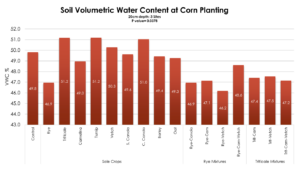2015 Annual Report for LNC13-352
Improved Cover Crop Options for Corn Belt Farmers
Summary
Seventeen cover crop treatments (nine sole-crops, five binary mixtures, two trinary mixtures, and a no cover-crop control) were planted in two environments in Iowa in October 2013 and three environments in October 2014 following harvest of soybean. Establishment was excellent in four environments, however, cover crops at one environment did not emerge prior to winter conditions arrival in 2014. Winter rye (“cereal rye”), winter triticale, Camelina sativa, and hairy vetch overwintered in 2013-2014 and 2014-2015, but Brassica napus, B. rapa, spring oat and barley entries did not. Cover crops differed significantly for stand density, accumulation of aboveground biomass, C and N in fall and the subsequent spring in 2014 and 2015. The C:N ratio of cover crop aboveground biomass and weed density differed among cover crop entries at termination. Winter rye, and mixtures with winter rye, produced greater amounts of biomass and accumulated more N and C than other cover crops or cover crop mixtures. Corn stand density, grain moisture at harvest, and weed community prior to the first in-crop herbicide application, did not vary for cover crop entry. Weed community in cover crops was dissimilar to weed community in subsequent corn in the first completed cycle of this study.
Objectives/Performance Targets
- Compare establishment, winter survival, biomass production, N and C accumulation, C:N ratio, and weed community in 17 cover crop treatments. Plant 17 cover crop treatments at three locations (environments) following soybean harvest annually (Table 1). Over two years, the cover crops were planted in five environments one or two days after soybean harvest (Table 2). We were unable to plant the cover crops at the Sutherland environment in 2013 due to excessive rains, which resulted in delayed planting and harvest of soybean that year. Stand establishment and density were assessed in the fall at three of the five environments (results not presented). Due to early freeze-up of soil, cover crops did not emerge at the Boone environment in fall 2014 due to late soybean harvest (29 October 2014) and late planting (30 October 2014). It was noted that most cover crop seed had germinated, but plants had not emerged by 11 November. Fall biomass and N and C accumulation were determined for cover crops at one of two planted environments in November 2013 and one of three planted locations in November 2014 due to limited cover crop growth (Table 3). Biomass and N and C accumulation in cover crops were assessed from five environments in May 2014 and 2015 prior to termination of cover crops (Figures 1, 2, and 3).
- Compare corn establishment, growth, N status, grain yield, and weed community following 17 cover crop treatments. This was done for all five environments when corn was planted after cover crop termination in 2014 and 2015 (Tables 4 and 5; Figure 5).
- Mr. Seth Appelgate was recruited as the M.S. candidate supported by this project. He completed his B.S. in Agronomy at Iowa State University and began employment in the second week of May 2014 and is on track to complete his MS degree in Crop Production & Physiology in 2016.
Accomplishments/Milestones
Cover crop establishment and productivity
Initial plant stand density and winter survival data of Camelina sativa continues to be promising as a cover crop in corn-soybean systems. Both Brassica napus canola varieties and B. rapa turnip established well, and survival was initially good at four environments, but none of these entries survived winter at any location. As expected, neither spring barley nor spring oat survived winter. Prior to termination before planting corn, fall-seeded cover crop entries differed for C and N concentrations, C:N ratio (results not presented) and accumulations (Table 2) in aboveground biomass. Binary and trinary cover crops mixtures were similar to corresponding sole-crop winter rye or triticale for the parameters measured in this study.
Corn productivity
Corn was planted in May 2014 following termination of cover crops (Table 1). At corn planting, soil volumetric water content (VWC) was decreased at 20-cm depth following winter rye (results not presented), but VWC was similar among cover crop entries at all subsequent dates (Table 5). Cover crop entry did not influence corn stand density (Table 5) or grain moisture at harvest (results not presented). Data were collected on corn leaf chlorophyll concentrations and corn growth and development (results not presented). Corn grain yield differed following cover crops from the Armstrong Farm environment (Table 5).
Weed community
Weed density did not vary in April 2014 among cover crop entries that were planted in October of 2013 (Table 2). The weed community in association with corn was composed of 24 species (results not presented). However, tall water hemp (Amaranthus tuberculatus) accounted for most of the total individuals observed. Marestail (Conyza canadensis) had the second highest density, and accounted for less than 1.1% of the total number of individuals observed. Cover crop entry did not significantly influence total weed density in corn prior to the first in-crop herbicide application (results not presented).
Figure 1
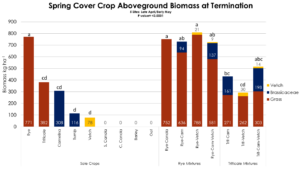
Figure 2
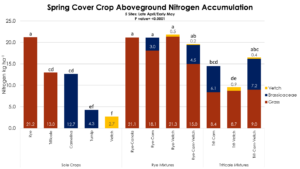
Figure 3
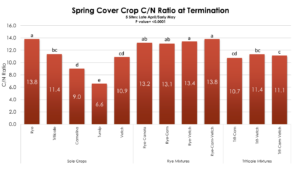
Figure 4
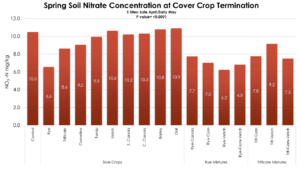
Figure 5
Table 1. Cover crop treatments and pure live seed (PLS) seeding rate.
|
Treatment |
Grass |
Brassicaceae |
Vetch |
|
|
________ kg ha-1 _________ |
||
|
Control |
0 0 0 |
||
|
Sole Crops |
|
|
|
|
‘Spooner’ Winter Rye |
67 |
|
|
|
‘Trical102’ Winter Triticale |
67 |
|
|
|
‘Bison’ Camelina |
|
6 |
|
|
‘Purple Top’ B. rapa (Turnip) |
|
6 |
|
|
Hairy Vetch (VNS) |
|
|
17 |
|
‘Sitro’ Canola |
|
6 |
|
|
‘Claremore’ Canola |
|
6 |
|
|
‘Tradition’ Spring Barley |
84 |
|
|
|
Spring Oat (VNS) |
84 |
|
|
|
Rye Mixtures |
|
|
|
|
Rye-‘Claremore’ Canola |
45 |
6 |
|
|
Rye-Camelina |
45 |
6 |
|
|
Rye-Vetch |
45 |
|
11 |
|
Rye-Camelina-Vetch |
45 |
6 |
11 |
|
Triticale Mixtures |
|
|
|
|
Triticale-Camelina |
45 |
6 |
|
|
Triticale-Vetch |
45 |
|
11 |
|
Triticale-Camelina-Vetch |
45 |
6 |
11 |
Table 2. Field operation dates, corn variety, and N fertilizer rates/forms for 5 Iowa research sites. Ames, Lewis 1; 2013-2014. Boone, Lewis2, Sutherland; 2014-2015.
|
Field Operation |
Ames |
Lewis1 |
Boone |
Lewis2 |
Sutherland |
|
|
|
|
|||||
|
Cover Crop Planting |
Oct. 10,11 |
Oct. 17,18 |
Oct. 29 |
Oct. 21 |
Oct. 14,15 |
|
|
Fall Cover Crop Harvest |
Nov. 9,10 |
na† |
na‡ |
Nov. 12 |
Nov. 13 |
|
|
Spring Weeds in Cover Crop |
Apr. 21 |
Apr. 21 |
May 12 |
Apr. 22 |
Apr. 28 |
|
|
Spring Cover Crop Harvest |
May 5 |
May 6 |
May 12 |
Apr. 22 |
Apr. 28 |
|
|
Spring Soil Sample |
May 5 |
May 6 |
May 13 |
Apr. 22 |
Apr. 28 |
|
|
Cover Crop Termination |
May 6 |
May 6 |
May 13 |
Apr. 23 |
Apr. 30 |
|
|
Corn Planting |
May 19 |
May 9 |
May 13 |
Apr. 29 |
Apr. 30 |
|
|
Initial Nitrogen Application |
na§ |
May 6 |
May 21 |
Apr. 29 |
May 6 |
|
|
Corn Population Sample |
June 9 |
June 10 |
June 10 |
May 21 |
May 21 |
|
|
Weeds in Corn |
June 3 |
June 10 |
June 1 |
May 21 |
May 21 |
|
|
Post Emergence Herbicide |
June 13 |
June 10 |
June1 |
May 21 |
June 16 |
|
|
In Corn Nitrogen Application |
June 26 |
June 16 |
July 2 |
June 18 |
July 2 |
|
|
Corn Harvest |
na¶ |
Oct. 16 |
Oct. 16 |
Oct. 22 |
Oct. 20 |
|
|
Corn Variety |
Pioneer P0453AM |
Wyffels 6626 |
Pioneer P0453AM |
Pioneer P0937 |
Pioneer P0297 |
|
|
Initial N Application Rate# |
0 |
156 |
135 |
135 |
135 |
|
|
Initial N Application Form |
|
32% UAN†† |
28% UAN |
32% UAN |
28% UAN |
|
|
In Corn N Application Rate |
80 |
56 |
67 |
67 |
67 |
|
|
In Corn N Application Form |
32% UAN |
32% UAN |
32% UAN |
32% UAN |
Dry Urea |
|
†na= not applicable; site data could not be collected due to lack of labor.
‡ na= not applicable; cover crops did not emerge.
- na= not applicable; initial N application never occurred.
¶ na= not applicable; site abandoned in July, frequent ponding and lack of N fertilizer.
# all N rates are kg ha-1 N.
†† UAN= urea ammonium nitrate.
Table 3. Fall aboveground biomass cover crop associated response variables. Cover crop biomass accumulation, cover crop carbon accumulation, cover crop nitrogen accumulation, cover crop C/N ratio for 3 Iowa sites 2013-2014.
|
Treatment † |
Biomass |
Carbon |
Nitrogen |
C:N ratio |
|
|
|
______________ kg ha-1 _______________ |
|
|||
|
Sole Crops |
|
|
|
|
|
|
Winter Rye |
56 ab |
25 a |
2.3 ab |
10.7 a |
|
|
Winter Triticale |
42 abcd |
19 abc |
1.9 abc |
10.0 abc |
|
|
Camelina |
20 cdefg |
7 bcde |
0.8 cdef |
9.3 cde |
|
|
Purple Top Turnip |
18 defg |
7 cde |
0.8 cdef |
8.8 fe |
|
|
Hairy Vetch |
5 g |
2 e |
0.3 f |
8.2 f |
|
|
‘Sitro’ Canola |
12 fg |
5 e |
0.5 ef |
9.0 def |
|
|
‘Claremore’ Canola |
13 efg |
5 de |
0.6 def |
8.3 f |
|
|
Spring Barley |
61 ab |
26 a |
3.1 a |
8.1 f |
|
|
Spring Oat |
42 abcde |
18 abc |
1.8 abcd |
9.6 cde |
|
|
Rye Mixtures |
|
|
|
|
|
|
Rye-‘Claremore’ Canola |
52 ab |
23 a |
2.3 ab |
10.2 abc |
|
|
Rye-Camelina |
68 a |
29 a |
2.8 ab |
10.5 ab |
|
|
Rye-Vetch |
61 ab |
27 a |
2.7 ab |
9.9 abc |
|
|
Rye-Camelina-Vetch |
48 abc |
20 a |
2.0 abc |
10.1 abc |
|
|
Triticale Mixtures |
|
|
|
|
|
|
Triticale-Camelina |
46 abcd |
19 abc |
1.8 bcde |
10.6 ab |
|
|
Triticale-Vetch |
39 bcdef |
17 abcd |
1.7 bcde |
9.7 abcd |
|
|
Triticale-Camelina-Vetch |
47 abcd |
19 ab |
2.0 abc |
9.9 abcd |
|
|
Significance |
|
|
|
||
|
Treatment |
*** |
*** |
*** |
*** |
|
|
P Value |
0.0007 |
0.0005 |
0.0011 |
0.0001 |
|
* Significant at P ≤ 0.05.
** Significant at P ≤ 0.01.
*** Significant at P ≤ 0.001.
† Means followed by different lower case letter within a column in a set are significantly different at P ≤ 0.05 by the least square means test.
Table 4. Spring cover crop associated response variables not affected by cover crop treatment. Mehlich-3 P at cover crop termination, Mehlich-3 K at cover crop termination, weed density in cover crop at cover crop termination, weed density in V2/V3 corn for 5 Iowa locations 2014-2015. Accumulated soil growing degree days (GDD, corn planting to 34 days after planting) for Boone location 2015.
|
Treatment |
M3P-P |
M3K-K |
Weeds in CC |
Weeds in Corn |
Soil GDD |
|
|
|
______ mg kg-1 ______ |
____ weeds m-2 ____ |
GDD °C† |
|||
|
Control- no cover crop |
16.3 |
145 |
69 |
88 |
500 |
|
|
Sole Crops |
|
|
|
|
|
|
|
Winter Rye |
17.1 |
151 |
67 |
75 |
508 |
|
|
Winter Triticale |
19.1 |
145 |
60 |
133 |
na‡ |
|
|
Camelina |
17.6 |
140 |
46 |
100 |
na |
|
|
Purple Top Turnip |
21.9 |
151 |
55 |
80 |
na |
|
|
Hairy Vetch |
19.4 |
149 |
75 |
88 |
na |
|
|
‘Sitro’ Canola |
19.7 |
146 |
69 |
99 |
na |
|
|
‘Claremore’ Canola |
20.7 |
143 |
69 |
80 |
na |
|
|
Spring Barley |
19.1 |
145 |
85 |
110 |
na |
|
|
Spring Oat |
17.4 |
146 |
82 |
92 |
na |
|
|
Rye Mixtures |
|
|
|
|
|
|
|
Rye-‘Claremore’ Canola |
17.0 |
148 |
52 |
80 |
na |
|
|
Rye-Camelina |
19.1 |
148 |
37 |
96 |
504 |
|
|
Rye-Vetch |
19.1 |
145 |
54 |
107 |
na |
|
|
Rye-Camelina-Vetch |
19.1 |
150 |
35 |
73 |
506 |
|
|
Triticale Mixtures |
|
|
|
|
|
|
|
Triticale-Camelina |
16.5 |
146 |
48 |
68 |
na |
|
|
Triticale-Vetch |
19.7 |
150 |
59 |
93 |
na |
|
|
Triticale-Camelina-Vetch |
15.4 |
150 |
44 |
73 |
na |
|
|
Significance |
|
|
|
|
|
|
|
Treatment |
NS§ |
NS |
NS |
NS |
NS |
|
|
P Value |
0.7572 |
0.8821 |
0.3160 |
0.7396 |
0.0648 |
|
|
Residual Standard Error |
6.8712 |
27.0004 |
136.70 |
598.93 |
2.2503 |
|
† Cumulative Growing Degree Days °C with Tmin=5°C, Tmax=30°C.
‡ na, not applicable, data not collected.
- Not significant.
Table 5. Spring corn associated response variables not affected by cover crop treatment. Corn population ×1000, soil volumetric water content (VWC; 7.6cm depth at corn planting, 7.6cm depth at V6 corn, 20cm depth at V6 corn, 7.6cm depth at R1 corn, 20cm depth at R1 corn), corn grain yield at 15.5% moisture for 4 Iowa locations 2014-2015.
|
Treatment |
Corn Pop |
VWC 7.6cm Planting† |
VWC 7.6cm V6 |
VWC 20cm V6 |
VWC 7.6cm R1 |
VWC 20cm R1 |
Grain Yield |
|
|||||||
|
|
Plants ha-1 |
___________________________ Soil VWC g kg-1 ___________________________ |
Mg ha-1 |
|
|||||||||||
|
Control- no cover crop |
74.8 |
337 |
335 |
518 |
329 |
485 |
14.0 |
||||||||
|
Sole Crops |
|
|
|
|
|
|
|
||||||||
|
Winter Rye |
74.5 |
282 |
349 |
542 |
326 |
492 |
14.2 |
||||||||
|
Winter Triticale |
75.5 |
340 |
355 |
543 |
333 |
507 |
13.9 |
||||||||
|
Camelina |
76.8 |
327 |
335 |
531 |
313 |
473 |
14.0 |
||||||||
|
Purple Top Turnip |
76.0 |
340 |
338 |
545 |
321 |
504 |
14.8 |
||||||||
|
Hairy Vetch |
76.0 |
351 |
356 |
537 |
327 |
496 |
14.6 |
||||||||
|
‘Sitro’ Canola |
75.2 |
342 |
331 |
529 |
327 |
495 |
14.5 |
||||||||
|
‘Claremore’ Canola |
74.6 |
346 |
323 |
540 |
312 |
491 |
14.3 |
||||||||
|
Spring Barley |
76.3 |
328 |
307 |
515 |
310 |
482 |
14.6 |
||||||||
|
Spring Oat |
75.3 |
340 |
344 |
520 |
344 |
483 |
14.5 |
||||||||
|
Rye Mixtures |
|
|
|
|
|
|
|
||||||||
|
Rye-‘Claremore’ Canola |
74.7 |
302 |
319 |
535 |
336 |
491 |
14.4 |
||||||||
|
Rye-Camelina |
73.8 |
287 |
327 |
540 |
313 |
482 |
13.3 |
||||||||
|
Rye-Vetch |
74.7 |
284 |
323 |
524 |
304 |
479 |
13.2 |
||||||||
|
Rye-Camelina-Vetch |
74.3 |
297 |
331 |
526 |
337 |
493 |
13.5 |
||||||||
|
Triticale Mixtures |
|
|
|
|
|
|
|
|
|||||||
|
Triticale-Camelina |
76.1 |
311 |
331 |
536 |
320 |
491 |
14.0 |
||||||||
|
Triticale-Vetch |
75.2 |
334 |
296 |
518 |
332 |
488 |
13.8 |
||||||||
|
Triticale-Camelina-Vetch |
75.4 |
296 |
327 |
530 |
329 |
478 |
13.7 |
||||||||
|
Significance |
|
|
|
|
|
|
|
|
|||||||
|
Treatment |
NS‡ |
NS |
NS |
NS |
NS |
NS |
NS |
||||||||
|
P Value |
0.8294 |
0.1159 |
0.2702 |
0.6712 |
0.8784 |
0.7262 |
0.2670 |
||||||||
|
Residual Standard Error |
1.4288 |
171.09 |
262.54 |
167.34 |
249.33 |
123.44 |
0.2231 |
||||||||
† VWC 7.6cm planting, data only for 3 locations, all in 2015.
‡ Not significant.
Impacts and Contributions/Outcomes
The project was started in October 2013. Insufficient time has passed for our project to have had large impacts and outcomes. However, funding of our project and description of cover crop treatments was presented in a webinar and four field days in 2015. Outputs for 2015 include planting cover crops at three sites in October 2014 followed by corn planting on the plots in 2015.
Collaborators:
Scientist
Practical Farmers of Iowa
600 Fifth St
Suite 100
Ames, IA 50010
Office Phone: 5152325661
Professor
Department of Agronomy, Iowa State University
2104 Agronomy Hall
Ames, IA 50011-1010
Office Phone: 5152943274
Website: http://www.agron.iastate.edu/personnel/userspage.aspx?id=730
